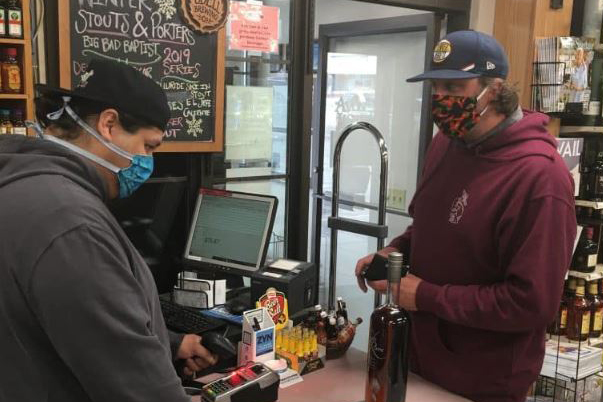News
Leader of Vail Health’s COVID-19 response says opening up the economy is vital

On May 25, Eagle County will transition to the next phase in its COVID-19 economic recovery, and that means as long as social distancing protocols are observed, restaurants can reopen and gatherings of up to 50 people will be allowed.
Many people will take these new guidelines as a sign that COVID-19 is on the wane, and that would be a misinterpretation.
“This virus isn’t leaving,” said Chris Lindley, who has been heading up Vail Health’s COVID-19 task force since January. “This virus transmits very easily. We aren’t going to stomp it out. Almost 90 percent of our population (in Eagle County) is still susceptible and is likely to contract COVID over the next 18 to 24 months.”
We aren’t living through an emergency that has been addressed, Lindley said. There are three major differences between pandemics and other disasters:
- They affect larger groups of people
- Lack of containment and threats to life are prolonged
- Illness and mortality come in waves
But we were never going to quarantine away COVID-19.
Sobering math
Lindley has the bona fides to make that prediction. His current position is executive director of Eagle Valley Behavioral Health and he is the county’s former public health director. He holds a master’s of public health, a master’s in the science of epidemiology and a master’s of business administration. He was a unit commander and environmental science officer of preventive medicine in the 793rd Medical Detachment of the United States Army Medical Reserves.
And, since January, Lindley has been tasked with leading Vail Health’s COVID-19 response.
As part of those duties, Lindley has been promoting testing and studying the numbers. COVID-19 hit Eagle County early and local testing efforts were robust. As a result, Eagle County leads the nation in testing per capita.
So, unlike other parts of the country where testing has not been as robust, Eagle County has been able to dial in its numbers. Vail Health estimates 6,300 people, or 11.5 percent of the local population, has contracted COVID-19 based on a sample size of the 3,400 people who have received antibody tests.
“We feel very confident that the underlying presence in our community of individuals with antibodies is 11.5%, and that number is not going to change,” Lindley said last week. “I guarantee you if we test another 1,000 people, it will be within another plus or minus one percent of that. This is a very, very large sample size, we have extreme confidence in it.”
The numbers also indicate the local mortality rate for COVID-19 is below .15%. The good news is that is much lower than the 5% to 6% national mortality figures, which are hampered by insufficient testing data.
But take that mortality rate and extrapolate it out to an actual number over the course of the COVID-19 pandemic and it is jarring. If nearly 90% of the county’s population is still susceptible to COVID-19, the virus remains a very deadly threat even with the lower mortality rate.
“This is what an infectious disease looks like. People get sick and people die. So, we want to be very clear,” Lindley said. “We could see 40 more deaths in our community over the next 18 to 24 months. That is the math. That is the epidemiology”
Lindley said local health care workers hope that dire prediction doesn’t come to pass and are working hard to keep COVID-19 mortality lower than the math predicts.
“But before this is all over, we may all personally know someone who has died from COVID-19. That is what happened in 1918 (during the Spanish flu pandemic).”
70% saturation
COVID-19 isn’t likely going away until we get to the 70% saturation point, Lindley said. That will either happen through exposure during the next 18 to 24 months or with the development of a vaccine.
“But we are a long way out from a vaccine. We can’t stay closed until a vaccine is available,” he said.
Lindley predicted that cases will trickle down during the summer months and rebound in the fall and winter. That is one of the best reasons for opening up the economy in the next couple of months, Lindley said.
“Eagle County needs to do a stress test this summer to be prepared for the winter,” he explained. “Let’s face it, we live and die by tourism and if we don’t have that, it affects all of us in one way or another.”
He said the goal is to bring back visitors this summer, knowing that only a fraction of the number of normal tourists will travel this year. That is a tough sell for some people.
Among the general public, Lindley said about half the population believes the county is moving too quickly toward reopening and the other half believes that the county isn’t moving quickly enough.
“Both are right,” he noted. “We worked very hard to scare everybody in early March not to go out. But things are very different now than they were in early March.”
More poor than sick
Lindley, in his role with Eagle Valley Behavioral Health, has first-hand knowledge that the consequences of a long-term economic shutdown are dire.
“More people will be getting poor than getting sick,” Lindley said. “It’s really hard to shelter in place if you don’t have shelter. People are not able to pay their mortgage. They are not able to pay their rent.”
The goal now has shifted from halting the COVID-19 spread and flattening the curve to spreading cases out over time to a manageable level, Lindley explained. With that shift, COVID-19 strategies have changed as well.
As the local economy opens up, more residents will contract COVID-19. But Eagle County has some major benefits as it faces more coronavirus in the community. First, the county has one of the healthiest populations in the nation, which means residents are better equipped to fight off the virus. Second, widespread testing means quicker diagnosis and treatment. Third, the curve has been flattened and the hospital is better prepared to handle an influx. Lindley noted that Vail Health has 86 beds available — 56 regular beds with the ability to surge to an extra 30.
Again, the numbers paint the picture:
- There have been 5 to 10 times as many local COVID-19 inpatients at Vail Health in just a few months compared to what the hospital has admitted for patients fighting influenza over a number of years.
- The average length of stay for a COVID patient is twice as long — four days — as the average length of stay for an influenza patient.
- So far, there have been 15 COVID-19 patients who needed treatment in an intensive care unit in Vail this year. For several years, the hospital has had no influenza patients in the ICU.
Personal responsibility will be the key component for success in the next battle of the COVID-19 war.
As businesses and community entities open up and COVID-19 spreads through the population, Lindley said behaviors such as hand washing, staying home when sick, getting tested when symptoms appear and following public health orders will be vital. The county has outlined its recommendations, as well as its COVID-19 plan for the summer months, in a document called the transition trail map.
“We must balance the health risks with the economic and behavioral health risks,” Lindley noted. “COVID is here to stay. The best thing we can do is learn how to live with it.”
Vail Health has compiled a report regarding its COVID-19 response and statistics and the document is updated daily. You can view it here.
More News
-
New!
More

Screening Secrets: What Every Man Should Know About Prostate Cancer Screening
Prostate cancer is the most common type of non-skin related cancer in men, and it is the second leading cause of cancer-related deaths in men within the United States, behind lung cancer. Fortunately, if caught early, prostate cancer remains highly treatable and curable with minimally invasive procedures.
-
New!
More

Unplug to Recharge: Why a Digital Detox Is the Real Power Move for 2026
Our phones promise connection, convenience and control, yet most of us feel more scattered, stressed and sleepless than ever. The constant pings, scrolls and notifications have rewired our brains for distraction. The fix? Not abandoning technology altogether, but reclaiming balance.
-
New!
More

Beyond the Scale: Why Nutrition and Exercise Work Better Together
For decades, weight loss advice has been distilled into a simple equation: calories in, calories out. Eat less, maybe combine that with exercise, and the pounds will fall away. But according to experts at Vail Health, that equation overlooks a much bigger picture.





